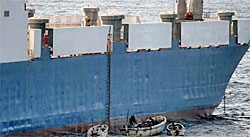In Denmark, Marstal Navigation School is setting up an anti piracy training scenario using the POLARIS Ship's Bridge Simulator. The objective of the course is to show the generic characteristics of piracy to give ship-owners, captains and crews tools for a tactical approach to sailing through piracy waters.

The anti piracy training is based on research and knowledge of the company Risk Intelligence, providing intelligence on pirates' behaviour, strengths and weaknesses, risk analyses and recommended lines of defence/actions.
"Once the crew know how to react the simulator is an excellent tool to practice drills to secure the crew's safety, communicate with the international naval forces and other evasive and defensive measures" says Bjorn Kay at Marstal Navigation School.
70 methods to avoid pirate attacks
According to Bjorn Kay there are up to 70 different methods to avoid pirates from boarding the vessel, none of which involve armed security staff on board. "Our opinion is that simulators can be used for research to qualify standards and best practices," he says.
The use of simulators
The simulator training is set up with merchant ships as 'own ships' and attack vessels (skiffs, dhows, etc) as 'target ships', using the facilities of the KONGSBERG Ship's Bridge Simulator to define parameters such as weather, wind conditions, sea state and different attack patterns.
The use of functionalities in the simulator like AIS/ECDIS and communication systems are essential to perform a good training scenario.
Identifying suspect vessels
The Bridge watch/crew/lookout and procedures are included in the training course, with particular emphasis on differentiating between normal and suspect activities typical for the sailing area. "The lookout has access to systems like AIS, ECDIS/maps, radar and news and information provided by the international naval coalition, but the visual bridge watch is equally important" claims Kay. "In Somalia for example, suspect vessels to pay attention to are small fast craft, fishing vessels, and dhows with a lot of crew or towing 2-3 smaller vessels. Here vessels to be monitored closely on the radar are e.g. ships that behave in an irregular, fashion, laying still close to transit corridors, where there is no reason to anchor or fish and one should also keep a close watch on vessels not sending AIS signals".
Psychological focus
Another important part of the training at Marstal will be the psychological aspects before and after the attack. At the end of a training session, the school will put emphasis on analysing the exercise in a debrief session.
Transferable knowledge
"The principles behind the training can also be used to train navy vessels patrolling the waters by offering structured information about pirate modus operandi and behaviour from the area, thereby making the military presence more efficient and offering better protections for the merchant fleet" concludes Bjorn Kay.